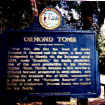|
|
||
|
|
||
|
The James Ormond Tomb Park is a little 13 acre park nestled between the Tomoka and Bulow state park. I wanted to do a story on this place because I felt that the whole history to the area is rather interesting and runs very deep into the development of Ormond Beach. But out in the middle of a grove of Oaks lays a tomb which reads "James Ormond, Died Sept. 30 1829, an honest man," the park was dedicated to the Ormond family. In 1945 the Volusia Park Service had the park donated to them which now is a historical monument. Many years ago the tomb was badly damaged by vandals but was restored and maintained by Maud Van Woy. Where the tomb stands today was the site of the "Damietta" an Indigo/Cotton plantation which was one of the most productive ones in the Halifax region which in turn was the last 9 years of James Ormond's Life & family spent here which was from 1820 to 1829. But lets take a step back in time to learn a little bit before the tomb came to be and lets delve into little bit of history on Captain James Ormond I. Him and his wife Russell Walker were born in Scotland. At the time he was the owner of the "Armed Brig" called Somerset in the service of the Panton, Leslie & Company. So another wards the Brig would travel all the way from Savannah to Apalachicola to the West Indies to trade with Indians in the state of Florida. The company from Scotland was quite successful as eventually Captain James Ormond settled in the Bahamas after he decided to no longer to captain a ship. He ran sugar plantation called Exuma and at the time the British owned the state of Florida so most plantations in the area where the park sits today were British owned. In 1783 Spain did regain Florida from England but at the time Florida remained full of Native American tribes and British settlers. But alot of the land was uninhabited. So what Spain did is offered large land grants to various individuals if they would move there family and themselves to Florida. Some of these land grants ranged from 1000 to 3000 acres. Captain James Ormond sold his plantation in Exuma and moved with other plantation owners such as Richard Oswald, Col. Thomas Dummett, John Addison, Robert McHardy, Robert McHardy, Richard Oswald, and David Fairchild to Volusia County in 1790s to the early 1800s. These men all had something in common in the fact they inherited from Spain large land grants and established plantations all near one another. The first plantation was located in New Smyrna which at the time was known as Spruce Creek an area perhaps we will visit some day since it ties into our journeys. The second area he received in a grant was 2,000 acres of land which was near Bulowville which at the time was a booming plantation near the Halifax River. During the 1800s James Ormond II spent most his time in Scotland growing up rather then on the plantation with his siblings and family. In 1817 Captain James Ormond was taking a walk with his son Emanuel when he was shot and killed by a run-away slave. Around this time he also was granted a large parcel of land known as Bulow State Park today however due his death he never was able to build a plantation on this area. He would later be buried on the Spruce Creek Plantations Property which is known as a place called Nordman's Point. Leaving the plantation in peril his wife Russell and son Emanuel went back to Scotland. This was also a time known as the First Seminole War so many in the area were being massacred to perhaps it was for safety that they left. In 1820 James Ormond II settled in the Damietta plantation perhaps to take his fathers place. In 1820 he found the land to be very friendly much different then Scotland's rolling hills but he was on good terms with many Indian chiefs such as King Philip, Billy Bowlegs, and Coacoochee. James Ormond II had in 1924 sent for his wife Isabella and his children Agnes, Russell, Helen, and James III. Five years later September 30, 1929 he passed on. However history does not tell us how he died a plaque leaves you with theories that perhaps it was the Rum, Mosquito's or Natives that killed him. But like many in the family over the years some were killed by tragic occurrences such as Indians, Escaped Slaves, Disease Etc. Life was not easy living in the Swamplands and because of this when James Ormond II died his wife and children fled to Charleston South Carolina abandoning the plantation. Damietta became the property of Samuel H. Williams which turned it into a Orange Grove Plantation. Little did he know that that during the second Seminole War that this plantation would be destroyed and from what I have read many were killed in the raids since the Seminoles burned it down. Perhaps either way the plantation was doomed since most of it was sold for failure to pay state and country taxes. Also in the 1830s the government defied the Indians and wanted the removal of them so they deported 3,200 to Oklahoma. But the Seminoles fought hard over the hunting and fishing territories perhaps because of this they went around the entire area burning down plantations, killing there families and probably even the slaves as well. The Seminoles wanted there freedom and the uprising lasted 7 years by 1842 Bulowville Plantation which also served as a military outpost, The Oswald Plantation, and Others were burnt to the ground leaving only remnants today. James Ormond III was a little older he became more involved with civil affairs. Perhaps that is why he returned not to own a plantation but maybe to defend the Ormond's good name. So during the Seminole War in 1836 he commanded a platoon called the "Mosquito Roarers" at the battle of Dunlawton. Years later in 1950 it was called Ormond Beach since the territory sat on a peninsula and along Daytona Beach. But before this in 1880 it was called Ormond which was named to honor the Ormond family which had removed the Colony of New Britain name. Which below you will find out how this came to be. The reason it was called New Britain is that in the 1870s John Anderson and Andrew Bostrom were brothers one from New Britain, Ct. the other from Maine settled in the area since at that time acreage was very inexpensive and they came here to start Orange Grove Plantations. At that time an older James Ormond III was friends with both plantation owners he even stayed on the Bostrom Plantation for sometime. Perhaps he shared tales of his Battle With the Seminoles and his fathers life. You can sort of vision it Ormond sitting near the fire telling tall tales about this area. These two brothers established the first residences in the area since for many years due to the Civil and Seminole Wars the area was very vacant. But as the town began to grow the settlers had a meeting on whether to incorporate the town of New Britain name and the brothers decided to incorporate the name to Ormond to honor the family since most of the historical occurrences revolved around this family that century. So as you can see there is alot of history to the entire area but perhaps it all started at this park which once was part of the plantation. Today many just visit the park to walk the trails, picnic, visit a part of history and take there kids to the playground. But imagine long long ago great fierce battles were fought, slaves worked picking cotton, pioneers built Coquina Sugar Mills and the area at one time had oranges growing. Now what we have is a Tomb surrounded by Oaks and still today a few thousand acres of woods and ruins in the area. Amanda felt that out of the entire area the park was the most haunted. I have to agree it is a very dark and gloomy park. You can feel that at one time people died here. Although its very pleasant and quit there was just feelings out in the woods near the tomb of being watched. You could not shake that uncomfortable feeling. But are there ghost here yes probably lots of them and we will return a couple more times to increase our investigations in depth of the area. © By Rick-AngelOfThyNight
|
||
|
In accordance with Title 17 U.S.C. Section 107, any copyrighted work on this page is being distributed under fair use without profit or payment to those who have expressed a prior interest in viewing the included information for non-profit research and educational or criticism purposes only. Notwithstanding the provisions of sections 106 and 106A, the fair use of a copyrighted work, including such use by reproduction in copies or phone records or by any other means specified by that section, for purposes such as criticism, comment, news reporting, teaching (including multiple copies for classroom use), scholarship, or research, is not an infringement. |
||
|
|
|






